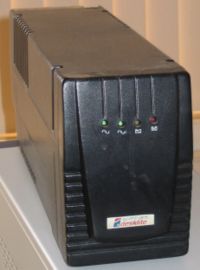
Photo from wikipedia
An ambient backscatter system could utilize the exiting ambient RF signals as both energy source and information carrier to enable the communications among battery-free devices and is deemed as a… Click to show full abstract
An ambient backscatter system could utilize the exiting ambient RF signals as both energy source and information carrier to enable the communications among battery-free devices and is deemed as a promising communication primitive for the Internet of Things (IoT). In this paper, we propose a time splitting strategy (TSS) and power splitting strategy (PSS) for the ambient backscatter system, where the tag-reflection coefficient is optimized according to dynamic channel variation. We also derive the analytical expressions of the outage probability and the optimal throughput for both the TSS and the PSS, which provides insights on the impact of system parameters, e.g., channel variance, RF source power, and circuit power consumption. The simulations showed that the proposed strategies can significantly outperform the traditional counterparts that rely on fixed reflection coefficient.
Journal Title: IEEE Access
Year Published: 2019
Link to full text (if available)
Share on Social Media: Sign Up to like & get
recommendations!